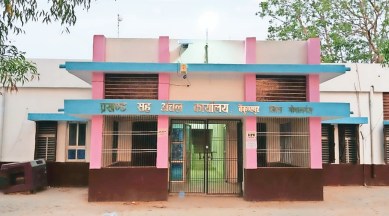Stay updated with the latest - Click here to follow us on Instagram
Small device, big deal: Bihar to tackle air pollution with better monitoring
The device, powered by a small solar panel, monitors air pollution in terms of particulate matter levels. With these sensors, Bihar will have more data this winter than it ever did before on its air pollution problem.

A SMALL device, only “a little bigger than a large-sized cellphone”, is tucked somewhere beneath parapets on 510 block development offices across Bihar.
The device, powered by a small solar panel, monitors air pollution in terms of particulate matter levels. With these sensors, Bihar will have more data this winter than it ever did before on its air pollution problem.
Bettiah, around 200 km to the northwest of Darbhanga, saw 25 such ‘severe’ air days from November 1 to January 31 last winter.
Darbhanga and Bettiah have a single continuous ambient air quality monitoring station each, of the Bihar Pollution Control Board, according to the CPCB’s list of continuous ambient air quality monitoring stations.
From January 15 to February 19, data for Darbhanga was not available in the CPCB bulletins.
Bihar, which is 63 times the size of Delhi in square kilometers, has just 35 continuous ambient air quality monitoring stations, less than around 40 in Delhi, going by the CPCB’s figures. Now, for a better sense of air pollution in the state, 510 sensors have been added to Bihar’s network, in a project that is being implemented by IIT Kanpur in collaboration with the governments of Bihar and Uttar Pradesh. A total of 840 sensors are slated to be installed in Uttar Pradesh as well.
The deployment in Bihar, except for Patna, was completed around three weeks ago, and the sensors are now being set up in Uttar Pradesh, where 20 have already been installed, said Sachchida Nand Tripathi, Professor at IIT Kanpur and Steering Committee member, National Clean Air Programme (NCAP).
“The idea is to set up one sensor in each block. We have been working in partnership with the State PCB and the Department of Rural Development in Bihar. In UP, it can take another three to five months,” he said.
“The data can help in effective air quality management. Take the example of Delhi – in 2013-14, when we had the first of those (pollution) episodes, we had a strength of a few monitors. Now, Delhi has nearly 40,” Tripathi said. “If you want to have sustained air quality management, and be on the upswing in terms of improving air quality, you need a good amount of good data. It enables and helps evaluate policy actions, and that is the only way we can correct ourselves and move forward in the right direction.”
These sensors, which measure only particulate matter as opposed to the government monitors that also measure gaseous pollutants, are cheaper than the government ones. But with sensors of lower cost, there is a need to ensure accuracy as well.
For this, Tripathi said that the sensors’ performance is assessed in a few ways to keep the errors as low as possible. “We first compare the sensors with the monitors that the government uses as part of the CAAQMS (Continuous Ambient Air Quality Monitoring Stations). Three test beds have been developed at IIT Kanpur where all sensors are placed next to the government monitors and we see if there are deviations. They should work reasonably well. Then they are shipped out to the districts and the blocks, where our team, the government team and the maintenance agency all deploy it. We have a team of postdocs and research associates who look into the data,” he said.
“It certainly won’t be as accurate as government monitors; it’s not expected to be. For the cost of one government monitor installed for particulate matter and its maintenance for a year, you can place 25 of these sensors,” he said.
“CAAQMS will not suffice to give adequate representation of particulate matter distribution across the country because they are too expensive… one such monitor costs Rs. 1.5 crore… including maintenance for a year. It’s all imported. So, we need a hybrid approach of some government monitors, augmented by sensors,” Tripathi said.
While PM10 and PM1 will also be measured, the team has worked so far on improving the accuracy of measurement of PM2.5. The sensors have been developed by IIT Kanpur and fabricated by start-ups.
Bihar Pollution Control Board Chairman D K Shukla said, “This is the first project of its kind, no state has covered every block. This can help with predicting pollution levels. It’s an important project.”
On how the project will help the state in pollution control, he said, “The basic thing is to understand what the pollutants are. If we have data from all blocks, we can analyse in what areas we need more effort.”
On the AQI levels last winter, Shukla said, “It’s a general problem in the Indo Gangetic Plain. In winter, wind speed is low and pollutants remain confined.”
Other states in the Indo Gangetic Plain, where pollution levels see a spike in winter on account of low temperature and wind speed, also have fewer air quality monitoring stations compared to Delhi.
The CPCB list of continuous ambient air quality monitoring stations shows that Punjab has eight such stations, while Haryana has 30 and West Bengal 14.